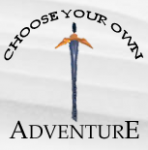I was listening to an On The Media interview of Bob Stein on the future of books and started to think about how to use collaborative writing in my class. Since we use our wiki allot (for practically everything), it occurred to me that the wiki is the ideal platform for students to write a  choose-your-own-adventure type story. A quick web search there is already a choose your own adventure website/wiki that is set up just for this.
choose-your-own-adventure type story. A quick web search there is already a choose your own adventure website/wiki that is set up just for this.
The way I envision it working in my class is that each student would write a section/chapter and end with a set of choices which would be links to new chapters. To make it interesting and more collaborative, very time students had to add to the story they would have to start from another student’s decision.
I really can’t wait to try this. I think I’ll make a new section of the story a weekly writing assignment.
